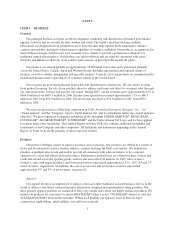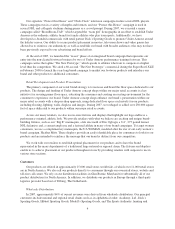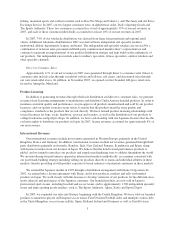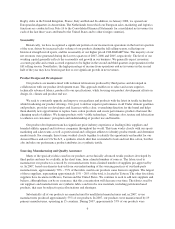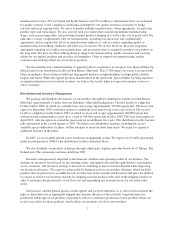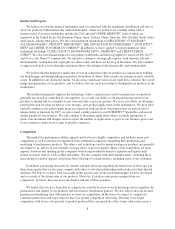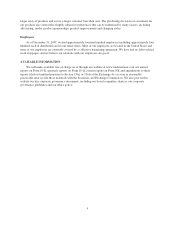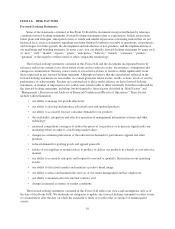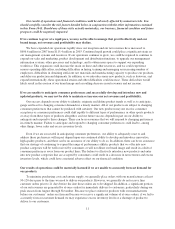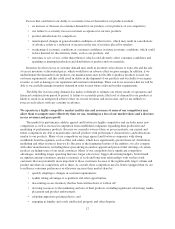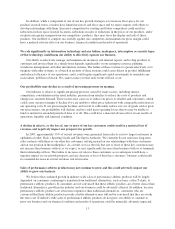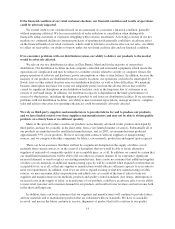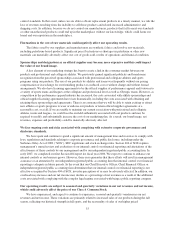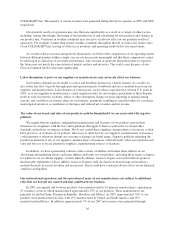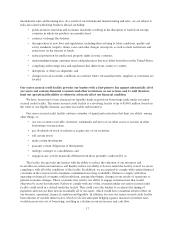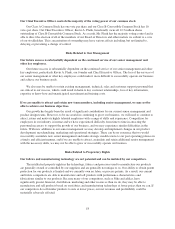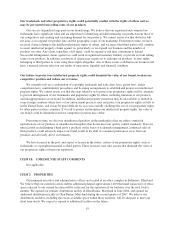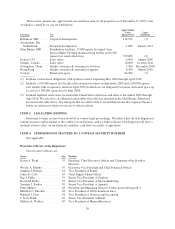Under Armour 2007 Annual Report Download - page 21
Download and view the complete annual report
Please find page 21 of the 2007 Under Armour annual report below. You can navigate through the pages in the report by either clicking on the pages listed below, or by using the keyword search tool below to find specific information within the annual report.Our results of operations and financial condition could be adversely affected by numerous risks. You
should carefully consider the risk factors detailed below in conjunction with the other information contained
in this Form 10-K. Should any of these risks actually materialize, our business, financial condition and future
prospects could be negatively impacted.
If we continue to grow at a rapid pace, we may not be able to manage that growth effectively and our
brand image, net revenues and profitability may decline.
We have expanded our operations rapidly since our inception and our net revenues have increased to
$606.6 million in 2007 from $115.4 million in 2003. Continued rapid growth could place a significant strain on
our management systems and resources. If our operations continue to grow, we could be required to continue to
expand our sales and marketing, product development and distribution functions, to upgrade our management
information systems, other processes and technology, and to obtain more space to support our expanding
workforce. This expansion could increase the strain on these and other resources, and we could experience
serious operating difficulties, including difficulties in hiring, training and managing an increasing number of
employees, difficulties in obtaining sufficient raw materials and manufacturing capacity to produce our products,
and delays in production and shipments. In addition, as we introduce more new products, such as footwear, and
expand internationally, these operational strains and other difficulties could increase. These difficulties would
likely result in the erosion of our brand image and a resulting decrease in net revenues and net income.
If we are unable to anticipate consumer preferences and successfully develop and introduce new and
updated products, we may not be able to maintain or increase our net revenues and profitability.
Our success depends on our ability to identify, originate and define product trends as well as to anticipate,
gauge and react to changing consumer demands in a timely manner. All of our products are subject to changing
consumer preferences that cannot be predicted with certainty. Our new products may not receive consumer
acceptance as consumer preferences could shift rapidly to different types of performance or other sports products
or away from these types of products altogether, and our future success depends in part on our ability to
anticipate and respond to these changes. There can be no assurance that we will respond to changing preferences
in a timely manner. Failure to anticipate and respond to changing consumer preferences could lead to, among
other things, lower sales and excess inventory levels.
Even if we are successful in anticipating consumer preferences, our ability to adequately react to and
address those preferences will in part depend upon our continued ability to develop and introduce innovative,
high-quality products, and there can be no assurance of our ability to do so. In addition, there can be no assurance
that our strategy of continuing to expand the range of performance athletic products that we offer into new
product categories will be well received by consumers or will not dilute our brand image and result in a shift of
consumer preferences away from our product lines. The failure to effectively introduce new products and enter
into new product categories that are accepted by consumers could result in a decrease in net revenues and excess
inventory levels, which could have a material adverse effect on our financial condition.
Our results of operations could be materially harmed if we are unable to accurately forecast demand for
our products.
To minimize purchasing costs and ensure supply, we generally place orders with our manufacturers at least
90-120 days prior to the time we need to deliver our products. However, we generally do not receive firm
customer orders prior to 21 days before the date those orders are to be shipped. In addition, a significant portion
of our net revenues are generated by at-once orders for immediate delivery to customers, particularly during our
peak season from August through November. Because we place orders for products with our manufacturers
before our customers’ orders are firm and because we receive a significant volume of at-once orders, if we fail to
accurately forecast customer demand we may experience excess inventory levels or a shortage of product to
deliver to our customers.
11


